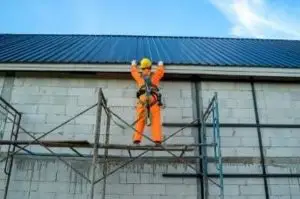The main fall protection standards are designed to keep you safe when working at height. In this blog post, we’ll take a look at the main fall protection standards and what they mean for your safety.
OSHA Fall Protection Standards
In order to reduce or prevent the incidence of injury, including death, due to falling from elevations, OSHA has created standards that address walking-working surfaces and fall protection. All general industry workplaces must comply with the provisions of these standards. Construction workplaces are also subject to these standards unless specifically exempted by a particular standard.
The primary standard that covers fall protection in construction is:
This subpart contains specific requirements for fall protection when working on scaffolds, ladders, stairways, and other walking-working surfaces. The standards require the use of guardrail systems, safety net systems, or personal fall arrest systems when working at heights greater than 6 feet (1.8 m).
The selection and use of these systems is dependent on the type of work being performed, the height of the potential fall, and other workplace conditions. In addition to the requirements in Subpart M, there are specific fall protection requirements in several other OSHA construction standards including those for excavations, residential construction, tunneling operations, and communication towers.
ANSI Fall Protection Standards
In order to provide consistent safety guidance, the American National Standards Institute (ANSI) has published a number of fall protection standards. Some of these are general in nature, while others are specific to certain types of equipment or work environments.
The three main ANSI standards relevant to fall protection are:
- ANSI Z359.1 – This standard covers general requirements for fall arrest systems, and applies to both personal Fall Arrest Systems (PFAS) and work positioning systems.
- ANSI A10.32 – This standard covers specific requirements for mobile elevated work platforms (MEWPs).
- ANSI A10.33 – This standard covers specific requirements for tower cranes.
In addition to these three main standards, there are also a number of other ANSI fall protection standards that cover specific topics such as lanyards, connectors, horizontal lifelines, and horizontal railings.
CSA Fall Protection Standards
In Canada, fall protection is governed by the Canadian Standards Association (CSA). The CSA Group has long been recognized as a leader in the development of comprehensive safety standards, covering a wide range of industries and products.
There are four main CSA fall protection standards:
- CSA Z259.2.1 – Fall Arresters, Vertical Lifelines, and Rails
- CSA Z259.2.3-14 – Body Belts and Full Body Harnesses
- CSA Z259.10-12 – Energy Absorbers and Lanyards
- CSA Z259.11-05 – Connecting Devices
European Union Fall Protection Standards
There are two main fall protection standards organizations used in the European Union:
- EN (European Norm)
- ANSI (American National Standards Institute)/OSHA (Occupational Safety and Health Administration) standards.
The EN standard is the more widely used of the two, as it covers a wider range of products and is regularly updated. The ANSI/OSHA standard, on the other hand, covers only a limited number of products and is not frequently updated.
Australian Fall Protection Standards
There are three main fall protection standards in Australia:
AS/NZS 1891.1:2016 is the standard for the design, selection, and installation of height safety systems. This standard applies to all new work and to the alteration, repair, or maintenance of existing height safety systems.
AS/NZS 4488:2015 is the standard for fall arrest systems and devices. This standard applies to all new work and to the alteration, repair, or maintenance of existing fall arrest systems and devices.
AS/NZS 4801:2001 is the standard for occupational health and safety management systems. This standard applies to all workplaces where there is a potential for harm to workers from falls from height.
New Zealand Fall Protection Standards
In New Zealand, there are three main fall protection standards:
- AS/NZS 1891.1:2007 Industrial Fall-arrest Systems and Devices
- AS/NZS 4288:1996 Personal Protection Equipment for Prevention of Falls from Heights
- NZS 4544:1999
Code of Practice for the Design, Installation, and Maintenance of Horizontal Lifelines AS/NZS 1891.1:2007 is the primary fall protection standard in New Zealand, as it provides guidance on the design, selection, installation, use, and maintenance of systems and devices intended to arrest a person who falls.
AS/NZS 4288:1996 is also an important standard, as it sets out requirements for personal protection equipment (PPE) to be used by workers when working at heights. NZS 4544:1999 provides guidance on the design, installation, and maintenance of horizontal lifelines – one of the most common types of fall protection systems.
South African Fall Protection Standards
There are three main fall protection standards in South Africa, which are:
- The Occupational Health and Safety Act (OHSA)
- The Construction Regulations
- The Mine Health and Safety Act (MHSA)
The OHSA covers all workplaces, while the Construction Regulations and MHSA specifically address construction sites and mines respectively. All three standards require employers to provide fall protection for employees who work at heights.
In Closing
While there are many fall protection standards in place in many countries, the key issue remains whether employers and workers will follow them. It is highly recommended to only install and use fall protection systems that meet or exceed the standards that apply to the industry you are working in.


